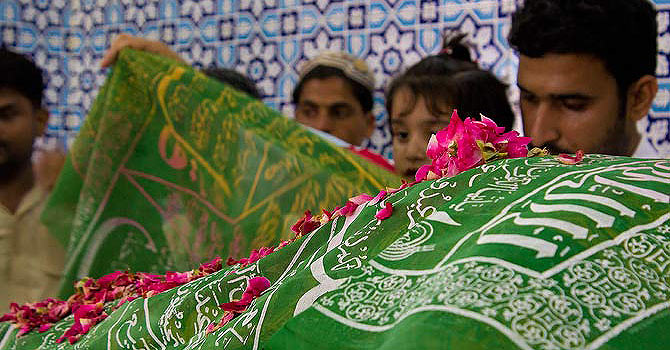KARACHI: While this metropolis has many structures dedicated to the structures of materialism and greed, its spiritual centre seems to be the majestic dargah on a hillock in Clifton — the final resting place of Abu Mohammad Abdullah al Ashtar, better known as Abdullah Shah Ghazi.
And come the Islamic month of Zilhaj — the last of the year — devotees flock to the dargah to celebrate the urs (death anniversary) of the Ghazi, from the 20th to the 22nd of the lunar month, this year corresponding to the 6th, 7th and 8th of November.
Though long an important event on Karachi’s religious calendar, due to the rampaging monster of terrorism, extra layers of security have been added to the urs preparations. This is for good reason; the shrine was bombed in October 2010 while last year, around the time of the urs a bomb blast occurred at the nearby Seaview.
Yet despite the acts of terrorism devotees continue to come. As this writer visited the dargah on Monday, a day before the urs festivities were to begin, there was a steady stream of people coming to pay their respects at the tomb of the Ghazi.
Devotees offering prayers at the shrine of Abdullah Shah Ghazi. — Photo by Shameen Khan/Dawn.comA visit to the dargah is always a spiritually refreshing experience. People of all backgrounds — but mostly the working and middle classes — are busy in contemplation, while for some it appears to be an ‘outing’. On the day this writer visited, a large number of families were making their way up the stairs to the tomb chamber — toddlers, old women in burkas, middle-aged men in shirts and trousers and everyone in between.
But before one could enter the tomb chamber to offer fateha and salaam, one had to pass through the security check. Private guards pad you down, following which you have to pass through a metal detector. A guard with an automatic weapon at the foot of the shrine’s stairs and several ambulances parked outside it were indicators that the times had changed; these images had mostly replaced the bevy of colourful malangs that formed the usual scenery at the dargah.
A woman reciting the Holy Quran at the shrine of Abdullah Shah Ghazi. — Photo by Shameen Khan/Dawn.comBut once one passes the security check, the warm familiarity of the mazaar welcomes the visitor into the sanctum sanctorum. The heady scent of incense and roses is pleasantly overpowering, as devotees file past the Ghazi’s tomb, offering fateha and kissing the chadors inscribed with Quranic verses placed onto the grave, as well as the foot of the tomb out of respect.
However, another sign that times have changed comes in the form of one of the shrine’s caretakers snapping at a young man to stop taking pictures of women with his mobile phone camera. For some people, no place is sacred.
It is difficult to come up with a definitive reason why people of the metropolis, and beyond, flock to the Ghazi’s tomb. After all, these are matters of the heart. Perhaps it is because of his reported lineage — Abdullah Shah is said to be a descendent of Imam Hasan al-Mujtaba, the second Imam, while he is said to be a Hussaini Saiyyad from his mother’s side. The people’s love for the family of the Holy Prophet (PBUH), the Ahlul Bayt, combined with his stature as a Ghazi, a pious warrior, perhaps attracts ordinary citizens to the tomb atop the hillock, in the hope that this noble soul with intercede on their behalf with the Almighty.
Letters written by devotees for the saint Abdullah Shah Ghazi. — Photo by Shameen Khan/Dawn.comWhat seems clear, though, is that Abdullah Shah was not a ‘Sufi’ in the popular sense. He may have been a pious individual descended from a noble clan, but his era predated the rise of the great Sufi orders by a few hundred years. He is said to have arrived in Sindh during the decline of Umayyad power and the rise of the Abbasids. Hence the popular concept that Abdullah Shah Ghazi is a ‘Sufi saint’ needs to be revisited. In fact what is sorely needed is a scholarly study of who Abdullah Shah was and why he came to Sindh.
Devotees pay their respect and prayers at the shrine of Abdullah Shah Ghazi. — Photo by Shameen Khan/Dawn.comWhatever the historical truth is, the fact of the matter is that the Ghazi’s shrine has a magnetism that draws all sorts to recharge their spiritual batteries.—QAM




















































Dear visitor, the comments section is undergoing an overhaul and will return soon.